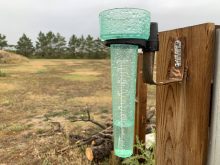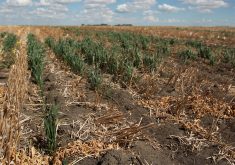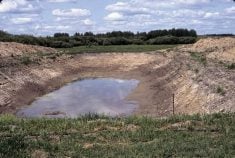Rapid onset droughts, which dry out soil within five days, have increased from three to 19 percent around the world
Recent research from the University of Texas at Austin, the Hong Kong Polytechnic University and Texas Tech University has shown that flash droughts are as threatening as flash floods and are developing much more quickly than traditional droughts.
Rapid onset droughts — those that dry out soils within five days — have increased from three to 19 percent. But in regions especially prone to flash drought, such as south and southeast Asia and central and western North America, the increase ranges from 22 to 59 percent.
Flash droughts are short-lived, lasting a few weeks or months, but they often occur during critical growing periods leading to crop failure.
Read Also

Using artificial intelligence in agriculture starts with the right data
Good data is critical as the agriculture sector increasingly adopts new AI technology to drive efficiency, sustainability and trust across all levels of the value chain.
In the summer of 2012, a flash drought in the central United States caused the collapse of the corn crop, which led to an estimated $35.7 billion in yield losses. The drought occurred with virtually no drying signal due to its unusual speed and intensity over the corn belt. It developed in May and peaked in August.
The 2018 flash drought that occurred over southern Queensland, Australia, de-vegetated the landscape and drove livestock numbers to the lowest level in the country.
“Just like flash floods, flash droughts come on fast, drying out soil in a matter of days to weeks and killing crops in the process,” said Shuo Wang, assistant professor with the Hydroclimate Research Group in the Department of Land Surveying and Geo-Informatics at Hong Kong Polytechnic University.
“Flash droughts have been receiving increasingly widespread attention from the hydroclimatic community because they evolve with a rapid depletion of soil moisture in a changing climate, which may cause more severe impacts on ecosystems, agriculture, and the environment than traditional, slowly evolving droughts.
“Although flash droughts are relatively new to science, the advancement of remote-sensing technology over the past couple of decades can help reveal instances of a rapid decline in soil moisture.”
Wang and his colleagues wrote in the report that flash droughts lack a consistent definition. They generally fall into two types, one based on the drought’s duration and the other on a drought’s rapid intensification rate.
Wang said that rapidly escalating drought has substantial impacts on agriculture in two ways. At the onset, soil surface drying leads to soil crusting, which may affect the ability of seeds to emerge and will reduce moisture infiltration rates, causing loss of water and reduction in crop yield.
Secondly, escalating drought is common in wet regions where vegetation has little adaptability to rapid dryness. The sudden stress can lead to plant mortality. In the face of both these challenges, the phenomenon of flash droughts has become a wider global threat.
“Instead of increasing the frequency of flash droughts, the world is faced with an increasingly rapid evolution of flash droughts, which poses a significant challenge for monitoring and forecasting,” said Wang.
In the study, the researchers captured a global picture of flash droughts based on the Global Land Evaporation Amsterdam Model (GLEAM) and NASA GLDAS-2 (Global Land Data Assimilation System Version 2) models. These systems provide satellite- and ground-based observation data on such conditions as sources of evaporation, transpiration, moisture loss and vegetation stress conditions.
Researchers were able to see a global picture of flash drought and how it had changed over the past 21 years from 2000-20. The data showed that 34 to 46 percent of flash droughts came on in about five days, the rest emerging within a month, with more than 70 percent developing in half a month or less accompanied by high intensification rates.
Generally, over the study time length, researchers recorded that flash droughts happened more quickly with greater impacts on crops compared to traditional droughts that may take five to six months to develop depending on climate variables.
“Crop losses are caused by flash drought according to duration and intensity,” said Wang. “In terms of time, longer duration often corresponds to larger crop losses, which is the same for traditional drought. On the other hand, the impact also comes with its rapid onset phase (intensity). Its suddenness with environmental anomalies during the onset phase of flash drought could have an impact on agriculture development. Farmers and communities have realized the threats of flash drought duration, but the intensity of flash drought is often ignored. During the onset phase of flash drought, temperature and vapour pressure deficit show a considerable increase in most regions of the world, whereas soil moisture and the amount of precipitation decrease.”
He said these changes demand greater requirements for plants to adapt compared with slowly evolving traditional droughts.
The study also focused on the importance of humidity and the influence of variable weather patterns with flash droughts becoming more likely when there is a shift from humid to arid conditions.
“This makes the regions that undergo seasonal swings in humidity such as Southeast Asia, the Amazon Basin, and the East Coast and Gulf Coast of the United States flash drought hot spots. Atmospheric aridity can create a flash-drought prone environment, so increasing humidity may moisten the air and alleviate atmospheric drying, thereby delaying or slowing down the start of a flash drought.”
Wang said he hopes their research findings can be incorporated into design criteria for drought-monitoring systems.
“For example, our research highlighted the importance of flash drought intensity during its onset phase, so the criterion of a rapid intensification rate should be taken into account, in addition to the relatively short-onset time scales for capturing the unique characteristics of flash droughts (rapid onset and rapid intensification).”
He recognized that the phenomenon of flash drought is still new to science and the underlying mechanism behind it is still elusive.
“Although we find that flash droughts can be triggered by land-atmosphere coupling, the accelerating onset of flash droughts can also be attributed to anthropogenic climate change, ocean‐atmosphere teleconnections and vegetation transpiration.
“Exploring the mechanisms of flash droughts would be challenging but a promising direction for revealing the mystery of flash drought onset. Thus, we will pay more attention to the physical mechanism behind flash drought occurrence in the future.”
The research was published in Nature Communications.















